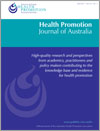
Health Promotion Journal of Australia
Volume 28 Number 1 2017
HEv28n1_ED1System reform in the human services: what role can health promotion play?
HEv28n1_ED2Positioning health promotion as a policy priority in Australia
HE16027Process evaluation of the Albany Physical Activity and Nutrition (APAN) program, a home-based intervention for metabolic syndrome and associated chronic disease risk in rural Australian adults
This paper reports on the process evaluation of the Albany Physical Activity and Nutrition program, which aimed to improve the diet and physical activity of rural adults at risk of chronic disease. Health promotion practitioners planning and implementing similar interventions may learn from these findings, particularly for recruitment and retention of participants.
HE16027 Abstract | HE16027 Full Text | HE16027PDF (120 KB) Open Access Article
HE15127How well are health information websites displayed on mobile phones? Implications for the readability of health information
Eighty-two percent of smartphone owners search for health information on their phones but is such information easy to read? This study explored how health information was displayed on mobile websites and found that only 15.93% were designed to optimise readability. Building mobile-responsive and easy-to-read websites should be a priority to capitalise on the potential of mobile phones in enhancing health literacy.
HE15127 Abstract | HE15127 Full Text | HE15127PDF (331 KB) Open Access Article
HE16003Consumer evaluation of ‘Veggycation®’, a website promoting the health benefits of vegetables
This study evaluated the Veggycation® website and its appeal to Australian consumers. The website has a high level of acceptance overall; however, customisation of the site is recommended for low vegetable consumption groups. The study adds to the body of knowledge in e-health and informatics, promoting health education and literacy.
HE15096Evaluating the Sharing Stories youth theatre program: an interactive theatre and drama-based strategy for sexual health promotion among multicultural youth
This study evaluated the effectiveness of the Sharing Stories youth theatre program, which uses interactive theatre and drama-based strategies to engage and educate multicultural youth on sexual health. The study found that knowledge, confidence and attitudes of participants improved after participation in the program. These results suggest that incorporating arts-based strategies into sexual health promotion programs for multicultural youth is valuable.
HE15096 Abstract | HE15096 Full Text | HE15096PDF (99 KB) Open Access Article
HE15128Is there a relationship between primary school children’s enjoyment of recess physical activities and health-related quality of life? A cross-sectional exploratory study
Recess breaks can provide the greatest opportunities for children’s physical activity participation at school. This study explored the relationship between Australian primary school children’s enjoyment of recess physical activities and health-related quality of life (HRQOL). Provision of opportunities and facilities for more vigorous-intensity school recess physical activities were found to be a key strategy to enhance children’s HRQOL.
HE16047Partnerships in obesity prevention: maximising co-benefits
Valuing the voices of community and stakeholders is vital to the evaluation of childhood community-based obesity prevention programs, especially to understand what works and why. This paper reports qualitative research about community partnerships in a program called OPAL (Obesity Prevention and Lifestyle) in South Australia. A key finding is that partnerships based on relationships and co-benefits were more likely to be viewed as making a difference.
HE15037Barriers and challenges affecting the contemporary church's engagement in health promotion
Churches have experience in addressing social disadvantage and are prepared to commit resources to meet the needs of people outside their congregations. The aim of this study was to explore the barriers and challenges that affect church involvement in promoting health and well being. Identified factors include perceived lack of relevance, community mistrust, conversion agendas and values that conflict with health promotion.
HE15118Depression and diabetes in the remote Torres Strait Islands
Torres Strait Islanders in the remote islands of Far North Queensland experience high rates of Type 2 Diabetes in Australia. This study aimed to assess the extent of self-reported depression using the PHQ-9 and clinical features, our study demonstrated low rates of depression compared to national samples. Increasing physical activity could improve mental and general well being in this population.
HE15095Online canteens: awareness, use, barriers to use, and the acceptability of potential online strategies to improve public health nutrition in primary schools
This telephone survey of 123 primary school principals suggests that online canteens have the potential to reach a large proportion of school communities across geographical and socioeconomic divides, and that the nutrition interventions which they have the capacity to deliver are considered acceptable.
HE15136Smoking status and associated factors among male Chinese restaurant workers in metropolitan Sydney
This is the first study focusing on smoking behaviour among Chinese restaurant workers in Australia. The findings indicate that Chinese restaurant workers in metropolitan Sydney have a high smoking rate of 45%, with 50% of current smokers wanting to quit. These findings provide a sound basis to support the development of tailored health promotion strategies for this population.
HE15123Take Charge of Pain: evaluating a community-targeted self-management education program for people with musculoskeletal pain
Self-management is ubiquitous in a modern health system, in which the management of chronic conditions is a key challenge. Using a pre-post evaluation design, this study aimed to determine the effectiveness of a redesigned and shortened community-targeted program focusing on musculoskeletal pain.

